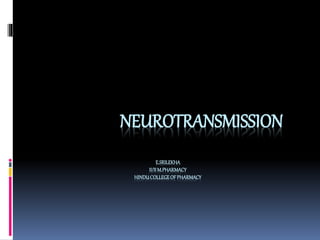
Neurotransmittors
- 2. INTRODUCTION Neurotransmitters are endogenous chemicals that transmit signals from a neuron to a target cell across a synapse.
- 3. Synapses are the junctions where neurons release a chemical neurotransmitter that acts on a postsynaptic target cell, which can be another neuron or a muscle or gland cell Some chemicals released by neurons have little or no direct effects on their own but can modify the effects of neurotransmitters. These chemicals are called neuromodulators.
- 4. Act as both neurotransmitters and hormones Most neurons make two or more neurotransmitters 50 or more neurotransmitters have been identified. 9 low molecular weight amines that serves as neurotransmitters egs. Glutamate ,the major fast excitatory transmitter in mammalian CNS , Acetycholine- the excitatory transmitter at the vertebral junction, GABA and Glycine ,the major fast inhibitory transmitters in brain & spinal cord. Central nervous system, the peripheral nervous system has only two: acetylcholine and norepinephrine.
- 6. STEPSINVOLVEDINNEUROHUMORALTRANSMISSION I. Impulse conduction: The resting trans membrane potential (70 mV negative inside) is established by high K+ permeability of axonal membrane and high axoplasmic concentration of this ion coupled with low Na+ permeability and its active extrusion from the neurone. Stimulation or arrival of an electrical impulse causes a sudden increase in Na+ conductance depolarization and overshoot (reverse polarization: inside becoming 20 mV positive); K+ ions then move out in the direction of their concentration gradient and repolarization is achieved. The ionic distribution is normalized during the refractory period by the activation of Na+ K+ pump. The action potential (AP) thus generated sets up local circuit currents which activate ionic channels at the next excitable part of the membrane (next node of Ranvier in myelinated fibre) and the AP is propagated without decrement. Tetrodotoxin (from puffer fish) and saxitoxin (from certain shell-fish) selectively abolish increase in Na+ conductance in nerve fibres and thus block impulse conduction.
- 7. II. Transmitter release: The transmitter (excitatory or inhibitory) is stored in pre junctional nerve endings within ‘synaptic vesicles’. (Fig. II.2).Nerve impulse promotes fusion of vesicular and axonal membranes through Ca2+ entry which fluidizes membranes. All contents of the vesicle (transmitter, enzymes and other proteins) are extruded (exocytosis) in the junctional cleft.
- 8. The release process can be modulated by the transmitter itself and by other agents through activation of specific receptors located on the prejunctional membrane, e.g. noradrenaline (NA) release is inhibited by NA (α2 receptor), dopamine, adenosine, prostaglandins and enkephalins while isoprenaline (β2 receptor) and angiotensin (AT1 receptor) increase NA release. Similarly, α2 and muscarinic agonists inhibit acetylcholine (ACh) release at autonomic neuroeffector sites (but not in ganglia and skeletal muscles). III. Transmitter action on postjunctional membrane: The released transmitter combines with specific receptors on the postjunctional membrane and depending on its nature induces an excitatory postsynaptic potential (EPSP) or an inhibitory postsynaptic potential (IPSP). EPSP Increase in permeability to cations Na+ or Ca2+ influx (through fast or slow channels) causes depolarization followed by K+ efflux.These ionic movements are passive as the flow is down the concentration gradients. IPSP Increase in permeability to anions, so that Cl¯ ions move in (axonal Cl¯ concentration is lower than its extracellular concentration) and tend to hyperpolarize the membrane an IPSP is generated. Stabilization of the membrane or hyperpolarization can also result from selective increase in permeability to K+ ions, which move out carrying +ive charges. In addition, a trophic influence on junctional morphology and functional status is exerted by the background basal release of the transmitter.
- 9. IV. Postjunctional activity: A supra threshold EPSP generates a propagated postjunctional AP which results in nerve impulse (in neurone), contraction (in muscle) or secretion (in gland). An IPSP stabilizes the postjunctional membrane and resists depolarizing stimuli. V. Termination of transmitter action: The various mechanisms of termination of transmitter action are depicted in Fig. II.3. Following its combination with the receptor, the transmitter is either locally degraded (e.g. ACh) or is partly taken back into the prejunctional neurone by active reuptake and partly diffuses away (e.g. NA). Specific carrier proteins like norepinephrine transporter (NET), dopamine transporter (DAT), serotonin transporter (SERT) are expressed on the axonal membrane for this purpose. The rate of termination of transmitter action governs the rate at which responses can be transmitted across a junction (1 to 1000/sec). Aminoacid transmitters (glutamate, GABA) are also partly taken up by active transport into neuronal and neighbouring glial cells, but no active reuptake of peptide neurotransmitters (VIP, NPY, enkephalins, etc.) occurs. They diffuse away and are broken down by peptidases at distant sites.
- 12. CHEMICALCLASSIFICATION OF NEUROTRANSMITTERS Cholinergics - Acetylcholine Biogenic Amines (modified amino acids) ,involved in slow synaptic transmission. Catecholamines: Dopamine, Norepinephrine (NE), and Epinephrine. Indolamines. Serotonin and Histamine (5-Hydroxytryptamine or 5-HT) Amino Acids - involved in fast synaptic transmission and are inhibitory and excitatory in action. GABA—Gamma ()-aminobutyric acid. Glycine , Aspartate ,Glutamate.
- 13. CHEMICALCLASSIFICATION CONT… NEUROPEPTIDES Formed by short chained peptides , slow acting synaptic transmitters. Eg:are Substance P, Endorphins and Enkephalins, Somatostatin,gastrin, cholecystokinin, oxytocin, vasopressin, Leutinizing hormone releasing hormone (LHRH) PURINES Adenosine ATP GASES AND LIPIDS Nitric Oxide (NO) Carbon monooxide (CO) Cannabinoids
- 14. FUNCTIONALCLASSIFICATION Excitatory Neurotransmitter- Eg: Glutamate,Aspartate,Adrenaline and Noradrenaline,Histamine,Nitric Oxide and Acetycholine Inhibitory Neurotransmitter– Eg:GABA,Glycine,Adrenaline and Noradrenaline,Dopamine and Serotonin.